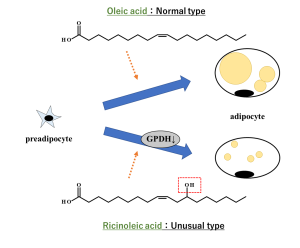Our paper has been accepted for publication in an international journal!
The following research paper by Nanaka Kaji and Hisho Omae, both graduates of the Yamamoto Laboratory, has been accepted for publication in the international journal Bioscience, Biotechnology, and Biochemistry. This is a joint research project with Matsuzaki Laboratory in the Department of Life and Environmental Science of our department.
Authors:Nanaka Kaji, Tsubasa Omae, Hidenori Matsuzaki, Yukihiro Yamamoto.
Title:Effect of four hydroxy fatty acids on lipid accumulation in the 3T3-L1 cells: A acomparative study. (May 27th 2024, accepted)
This study evaluated the physiological functions of an unusual type of fatty acid called “hydroxy fatty acids” (Figure 1).
Fatty acids are the constituents of fats and oils, of which there are many types such as oleic acid, linoleic acid, and α-linolenic acid, and the nutritional function of fats and oils is determined by these fatty acids.
Hydroxy fatty acids” are fatty acids that contain hydroxy groups (-OH) and are different in form from normal fatty acids. Among the physiological functions of hydroxy fatty acids, few studies have evaluated their anti-obesity effects.
Therefore, we evaluated the anti-obesity effects of several hydroxy fatty acids using cultured cells.
As a result, it was found that all of the tested “hydroxy fatty acids” showed anti-obesity effects, and we were also able to partially clarify their molecular mechanisms. Although the words “fat” and “fatty acid” may not have a positive image, they actually have interesting functions.

Figure 1. Overview of this study: Adipocytes grow from something called precursor fat cells to become fat cells. Treatment with the “hydroxy fatty acids” used in this study was found to suppress the action of an enzyme called GPDH and reduce the amount of fat stored in fat cells. The ricinoleic acid shown in the figure is found in a seed called castor seed.

